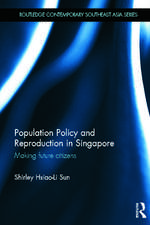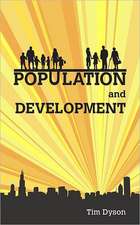International Handbook of Adult Mortality: International Handbooks of Population, cartea 2
Editat de Richard G. Rogers, Eileen M. Crimminsen Limba Engleză Paperback – 21 apr 2013
| Toate formatele și edițiile | Preț | Express |
|---|---|---|
| Paperback (1) | 1841.47 lei 38-45 zile | |
| SPRINGER NETHERLANDS – 21 apr 2013 | 1841.47 lei 38-45 zile | |
| Hardback (1) | 1853.48 lei 38-45 zile | |
| SPRINGER NETHERLANDS – 20 feb 2011 | 1853.48 lei 38-45 zile |
Preț: 1841.47 lei
Preț vechi: 2422.98 lei
-24% Nou
Puncte Express: 2762
Preț estimativ în valută:
352.36€ • 367.89$ • 291.63£
352.36€ • 367.89$ • 291.63£
Carte tipărită la comandă
Livrare economică 31 martie-07 aprilie
Preluare comenzi: 021 569.72.76
Specificații
ISBN-13: 9789400735361
ISBN-10: 9400735367
Pagini: 640
Ilustrații: XIV, 626 p.
Dimensiuni: 193 x 260 x 34 mm
Greutate: 1.25 kg
Ediția:2011
Editura: SPRINGER NETHERLANDS
Colecția Springer
Seria International Handbooks of Population
Locul publicării:Dordrecht, Netherlands
ISBN-10: 9400735367
Pagini: 640
Ilustrații: XIV, 626 p.
Dimensiuni: 193 x 260 x 34 mm
Greutate: 1.25 kg
Ediția:2011
Editura: SPRINGER NETHERLANDS
Colecția Springer
Seria International Handbooks of Population
Locul publicării:Dordrecht, Netherlands
Public țintă
ResearchCuprins
Introduction – Mortality Framework and Context : Richard Rogers and Eileen Crimmins.- Part 1: Historical Trends.- Chapter 1. Historical Trends in Mortality: France Meslé and Jacques Vallin, INED.- Part 2: Temporal and Spatial Trends Associated with Mortality.- Chapter 2. Comparative International Trends: Europe: Marc Luy, Christian Wegner, Wolfgang Lutz, IIASA, and Vienna Institute of Demography, Austrian Academy of Sciences.- Chapter 3. Adult Mortality in the Former Soviet Union: Michael Murphy, London School of Economics.- Chapter 4. Latin America and the Caribbean from 1850 to the Present: Alberto Palloni, Northwestern University.- Chapter 5. Adult Mortality in Asia: Zhongwei Zhao, Australian National University.- Chapter 6. Adult Mortality Trends in Africa: Georges Reniers, Princeton University, Bruno Masquelier, UCL, Belgium, and Patrick Gerland, UN.- Chapter 7. Global Trends in AIDS Mortality: John Bongaarts, Population Council, and François Pelletier, United Nations Population Division, and Patrick Gerland, UN Pop. Division.- Part 3: Sociodemographic, Economic, and Psychological Determinants of Mortality.- Chapter 8. Early Life Conditions and Later Life Mortality: Jennifer Karas Montez Mark Hayward, University of Texas at Austin.- Chapter 9. Age Patterns in Adult Mortality, with a Focus on Centenarians: Jean-Marie Robine, INSERM.- Chapter 10. Sex and Gender Differences in Mortality: Richard G. Rogers, Bethany G. Everett, and Robert J. Kemp, University of Colorado.- Chapter 11. The Hispanic Paradox: Kyriakos S. Markides and Karl Eschbach, University of Texas Medical Branch.- Chapter 12. Educational Attainment and Adult Mortality: Robert A. Hummer and Joseph T. Lariscy, University of Texas at Austin.- Chapter 13: Work, Occupation, Income, and Mortality: Patrick Krueger, University of Texas School of Public Health, and Sarah A. Burgard, University of Michigan.- Chapter 14. The Influence of Health Behaviors on Mortality: Christine L. Himes, SyracuseUniversity.- Chapter 15. Discrimination, Chronic Stress, and Mortality among Black Americans: A Life-Course Framework: James Jackson, Darrell Hudson, Kiarri Kershaw, Briana Mezuk, Jane Rafferty, and Katherine Knight Tuttle, University of Michigan.- Chapter 16. Self-Rated Assessments of Mortality: Marja Jylhä, University of Tampere, Finland.- Chapter 17. Religion and Adult Mortality: Ellen Idler, Rutgers University.- Part 4: Biological Risk Factors.- Chapter 18. Links between Biomarkers and Mortality: Eileen Crimmins and Sarinnapha Vasunilashorn, University of Southern California.- Chapter 19. Genetic Factors and Adult Mortality: Kaare Christensen, University of Southern Denmark, and James W. Vaupel, Max Planck Institute for Demographic Research.- Part 5: Contextual Effects on Mortality.- Chapter 20. Neighborhood Effects on Mortality: Arijit Nandi and Ichiro Kawachi, Harvard University.- Chapter 21. Health and Mortality Consequences of the Physical Environment: Christopher Browning, Ohio State University, Eileen E. Bjornstrom, University of Missouri, and Kathleen A. Cagney, University of Chicago.- Part 6: Classification of Causes of Death.- Chapter 22. Coding and Classifying Causes of Death: Trends and International Differences: Robert N. Anderson, National Center for Health Statistics.- Chapter 23. Avoidable Mortality: A Review: Hiram Beltrán-Sánchez, University of Southern California.- Part 7: Mathematical and Modeling Approaches to Mortality.- Chapter 24. Model Schedules of Mortality: Patrick Heuveline, UCLA and Sam Clark, University of Washington.- Chapter 25. Period versus Cohort Mortality: Michel Guillot, University of Pennsylvania.- Chapter 26. Healthy Life Expectancy: Carol Jagger, University of Leicester, and Jean-Marie Robine, French Institute of Health and Medicinal Research, INSERM.- Part 8: Government Policies Designed to Affect Mortality.- Chapter 27. Mortality Avoidable by Health Care and Public Health and Policy Interventions: Luc Bonneux, NIDI.-Chapter 28. Government Policies Intended to Influence Adult Mortality: S. Jay Olshansky, University of Illinois at Chicago, and Dana Goldman, RAND.- Conclusion: Richard Rogers and Eileen Crimmins.
Recenzii
"Over the past few decades researchers have generated numerous publications highlighting advances in trends and determinants of adult mortality changes. Now, Richard Rogers and Eileen Crimmins have engaged many of the leading contributors to that storehouse of information to place in a single volume the present state of knowledge about human adult mortality, its variations over time and place and its many causes, as well as influential policy formulations. The book’s rich and elaborate treatment of the subject, including methodological considerations and extensive literature reviews, establishes a benchmark for monitoring future developments of the subject that other researchers and students will rely on for years to come".
Charles B. Nam, Distinguished Research Professor Emeritus, Florida State University
"There is very considerable diversity both within and among countries in the mortality experience of adults, and this diversity is well captured, described and explained in the course of this book. This wide-ranging and exhaustive collection of studies of adult mortality gives a fascinating account. A complete analysis of the characteristics of adult morality and its extension to the morbid process preceding death, but above all the involvement of scholars from various disciplines, make this book an important reference point not only for the academic world – researchers, teachers and students – but also for the political world and those working in the health services. Its contents are particularly valuable for implementing health and social policies that aim to reduce the consequences of inequality and thus to provide better health for all".
Graziella Caselli, University of Rome “La Sapienza”.
"This book is a landmark publication. It comes close to being a recipe for a long and healthy life. The book lays out the factors that explain the gains in life expectancy and healthexpectancy witnessed across the world. They are genetic, behavioral, social, environmental and institutional. Richard Rogers and Eileen Crimmins assembled an interdisciplinary team of first-class scientists from different countries of the world to uncover the secrets of avoidable mortality and delayed morbidity. The book also documents why in some countries life expectancy stagnated and in some places even declined. The historical and global perspective on mortality change makes the International Handbook of Adult Mortality a must-read for anyone interested in living longer and postponing disease and disability. The book will be a standard reference for years to come".
Frans Willekens, Netherlands Interdisciplinary Demographic Institute (NIDI)
"An outstanding job of organizing and synthesizing knowledge in all of the important areas of research on adult mortality. By consolidating a surprisingly rich array of major research accomplishments, the volume sets the stage for rapid advances in the future."
Samuel H. Preston, Fredrick J. Warren Professor of Demography, University of Pennsylvania
Charles B. Nam, Distinguished Research Professor Emeritus, Florida State University
"There is very considerable diversity both within and among countries in the mortality experience of adults, and this diversity is well captured, described and explained in the course of this book. This wide-ranging and exhaustive collection of studies of adult mortality gives a fascinating account. A complete analysis of the characteristics of adult morality and its extension to the morbid process preceding death, but above all the involvement of scholars from various disciplines, make this book an important reference point not only for the academic world – researchers, teachers and students – but also for the political world and those working in the health services. Its contents are particularly valuable for implementing health and social policies that aim to reduce the consequences of inequality and thus to provide better health for all".
Graziella Caselli, University of Rome “La Sapienza”.
"This book is a landmark publication. It comes close to being a recipe for a long and healthy life. The book lays out the factors that explain the gains in life expectancy and healthexpectancy witnessed across the world. They are genetic, behavioral, social, environmental and institutional. Richard Rogers and Eileen Crimmins assembled an interdisciplinary team of first-class scientists from different countries of the world to uncover the secrets of avoidable mortality and delayed morbidity. The book also documents why in some countries life expectancy stagnated and in some places even declined. The historical and global perspective on mortality change makes the International Handbook of Adult Mortality a must-read for anyone interested in living longer and postponing disease and disability. The book will be a standard reference for years to come".
Frans Willekens, Netherlands Interdisciplinary Demographic Institute (NIDI)
"An outstanding job of organizing and synthesizing knowledge in all of the important areas of research on adult mortality. By consolidating a surprisingly rich array of major research accomplishments, the volume sets the stage for rapid advances in the future."
Samuel H. Preston, Fredrick J. Warren Professor of Demography, University of Pennsylvania
Textul de pe ultima copertă
This handbook presents a comprehensive and up-to-date overview of unprecedented substantive, theoretical, methodological, and statistical developments and insights, and an in-depth examination of trends and patterns, in adult mortality around the world. With over two dozen chapters and more than fifty authors, this volume draws from top international mortality experts to provide one of the best overviews of life expectancy extant. The handbook documents remarkable gains in life expectancy, which stand out as one of the most important accomplishments of the twentieth century. Individuals in more developed countries can expect to live longer now than ever before, especially the Japanese, who enjoy record-setting life expectancies. The book also explores unfortunate declines in life expectancy in selected countries brought on by such factors as the following: infectious diseases; accidents, suicides, and homicides; and political and economic conflict and turmoil. This book synthesizes the wealth of mortality information available, clearly articulates the central findings to-date, identifies the most appropriate datasets and methods currently available, illuminates the central research questions, and develops an agenda to address these research questions. The authors carefully examine central factors related to mortality, including health behaviors, socioeconomic status, social relations, biomarkers, and genetic factors. The book will prove especially relevant to researchers, students, and policy makers within social and health sciences who want to better understand international trends and patterns in adult mortality.
Caracteristici
Includes comprehensive coverage of adult mortality differentials worldwide Identifies and discusses central factors related to mortality risk Documents and explains mortality differentials Contributions by authors from top universities, research centers, and government organizations from around the world



























